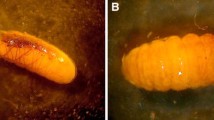Summary
Many species of the paleotropic plant genus Macaranga (Euphorbiaceae) live in symbiosis with the ant genus Cremastogaster (Myrmicinae), especially with C. borneensis. The ants protect their plants from many herbivorous enemies. The plants provide food-bodies and nesting space in the internodes. In addition the ants care for honeydew producing scale insects in these spaces. The caterpillars of several species of the genus Arhopala (Lycaenidae) parasitize on this symbiosis system. With the aid of their myrmecophilic organs the caterpillars overcome the aggressivity of the ants and feed on the Macaranga leaves without disturbance. Moreover the caterpillars and their pupae are protected against parasites and predators by the ants. As the female butterflies oviposit the eggs only in low numbers upon young leaves, the plants are not seriously affected.
The larvae of the three Arhopala species; A. amphimuta, A. moolaiana, and A. zylda are adapted to their host plant species Macaranga triloba, M. hulletti, and M. hypoleuca by means of color, shape, and behavior. In addition, the different larval stages change their appearance according to the parts of the plant on which they feed and rest. These cryptic adaptations point to a distinct monophagy of these butterflies.
The state of phylogenetic relationship within the three lycaenids is parallel to the relationship among the three host plants.
Similar content being viewed by others
References
Corbet A, Pendlebury H, Eliot J (1978) The butterflies of the Malay peninsula. Kuala Lumpur: Art Printing Works
Hinton E (1951) Myrmecophilous lycaenidae and other lepidoptera — a summary. Proc South London entomol nat hist Soc 1949–1959, 111–175
Malicky H (1969) Versuch einer Analyse der ökologischen Beziehungen zwischen Lycaeniden und Formiciden. Tijdschrift voor Entomol 112:213–298
Morell L (1956) Notes on the life histories of a number of butterflies of the subfamily Teclinae (Luycaenidae). Malayan Nature J 10:104–108
Ong Siew Ling (1978) Ecology of the ant association in Macaranga triloba. Thesis, University of Malaya, Kuala Lumpur
Pierce NE, Mead PS (1981) Parasitoids as selective agents in the symbiosis between lycaenid butterfly larvae and ants. Science 211:1185–1187
Tho Yow Pong (1978) Living in harmony. Nature Malaysiana 3:34–39
Whitmore T (1969) First thoughts on species evolution in Malayan Macaranga. Biol J Linnean Soc London 1:223–231
Author information
Authors and Affiliations
Additional information
This work was supported by the Deutsche Forschungsgemeinschaft. We are indebted to Mr. Eliot, Taunton, UK, for the identification of the lycaenids, for stimulating discussions and literature hints
Rights and permissions
About this article
Cite this article
Maschwitz, U., Schroth, M., Hänel, H. et al. Lycaenids parasitizing symbiotic plant-ant partnerships. Oecologia 64, 78–80 (1984). https://doi.org/10.1007/BF00377547
Received:
Issue Date:
DOI: https://doi.org/10.1007/BF00377547




